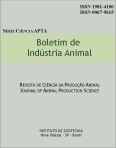Ingestive behavior of Nellore and Bonsmara cattle during the feed efficiency test
Keywords:
beed cattle, behavioral traits, feed efficiencyAbstract
This study was conducted to describe the ingestive behavior in Nellore and Bonsmara cattle during the feed efficiency test. The test was performed at the Centro APTA Bovinos de Corte €“ Instituto de Zootecnia, Sertãozinho, São Paulo State. Twenty-three Nellore and 19 Bonsmara calves, aging 276 ± 19.2 and 278 ± 29.2 days and weighing 246 ± 26.7 and 273 ± 30.7 kg, on average, at the beginning of the test, respectively, were used. Animals were randomly located in individual pens, during four periods of 28 days, being the first period a pre-test adjustment period. Calves were fed twice a day, with the same diet. Daily the amount of food offered was adjusted in order to maintain 5 to 10% of refusals. Dry matter intake (DMI) was calculated by the difference between food offered and refusals. Animals were weighed each seven days. Average daily gain (ADG) was obtained by linear regression of weights in days in test. Feed conversion was obtained by the DMI:ADG ratio. Ingestive behavior was measured three times, every 28 days, excluding de pre-test period. Observations lasted 24 hours, with records at intervals of five minutes. The behavioral traits analyzed were: bunk attendance duration (BAD), rumination time (RT) and idle time (IT) expressed in minutes per day. Data were analyzed using the PROC MIXED procedure (SAS 9.3). The model included the fixed effects of period, breed and weight nested in breed. The weight nested in breed effect was significant for all traits analyzed (P<0.05). The breed effect was significant for BAD, RT, IT, e ADG (P<0.05). Nellore calves had higher means for ADG, BAD and RT and lower mean for IT (P<0.05) than Bonsmara calves. There were significant differences among periods for traits ADG, BAD and IT (P<0.05), showing that the animals had greater weight gain at the beginning of the feed efficiency test because they had spent more time feeding and consequently less time in idle. Thus, it is evident that there are differences in ingestive behavior of Nellore and Bonsmara and among periods of test, showing that the animals spend more time feeding at the beginning. This fact is the probable reason for higher weight gain at this stage.Downloads
Downloads
Published
Issue
Section
License
Os autores não serão remunerados pela publicação de trabalhos, pois devem abrir mão de seus direitos autorais em favor deste periódico. Por outro lado, os autores ficam autorizados a publicar seus artigos, simultaneamente, em repositórios da instituição de sua origem, desde que citada a fonte da publicação original seja Boletim de Indústria Animal. A revista se reserva o direito de efetuar, nos originais, alterações de ordem normativa, ortográfica e gramatical, com vistas a manter o padrão culto da língua e a credibilidade do veículo. Respeitará, no entanto, o estilo de escrever dos autores. Alterações, correções ou sugestões de ordem conceitual serão encaminhadas aos autores, quando necessário. Nesses casos, os artigos, depois de adequados, deverão ser submetidos a nova apreciação. As opiniões emitidas pelos autores dos artigos são de sua exclusiva responsabilidade. Todo o conteúdo deste periódico, exceto onde está identificado, está licenciado sob a Licença Creative Commons Attribution (CC-BY-NC). A condição BY implica que os licenciados podem copiar, distribuir, exibir e executar a obra e fazer trabalhos derivados com base em que só se dão o autor ou licenciante os créditos na forma especificada por estes. A cláusula NC significa que os licenciados podem copiar, distribuir, exibir e executar a obra e fazer trabalhos derivados com base apenas para fins não comerciais.













